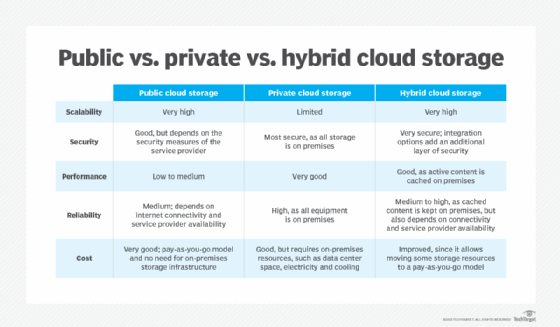backup storage device
What is a backup storage device?
A backup storage device is used to make copies of data that's actively in use. It provides redundancy of data residing on primary storage. Should the storage medium -- such as a hard disk drive (HDD) -- fail or become corrupted, the original data can be recovered from copies on the backup hardware.
The use of backup storage is imperative in enterprise environments, where any type of data loss can be potentially catastrophic.
Backup storage devices for enterprise use
Enterprise backup systems safeguard an organization's data by protecting, storing and defending it against natural disasters, human error and cyber attacks. An enterprise backup storage device is an integral part of an enterprise backup system and refers to a type of disk-based hardware appliance bundled with software for data management and data services. The physical device provides capacity via the internal storage media, while the backup software schedules policies for moving data in a tiered storage environment from primary to secondary storage -- also known as auxiliary or external storage.
Backup devices connect to storage using traditional Network File System or Internet Small Computer System Interface network protocols. Using replication and other data protection methods, a backup storage device is designated as a storage target for data copies.
In an enterprise, backup storage is achieved through replication of data in multidisk storage systems, such as redundant array of independent disks (RAID), or as part of a network-attached storage (NAS) or tiered storage system. Enterprise backup storage often uses both disk and tape as storage media. Special software is used to manage backups as part of a storage system.
This article is part of
Create your data backup strategy: A comprehensive guide
The same means and media used for backup storage are often used for archival storage.
Remote backup appliances
A remote backup appliance works similarly to a traditional backup device, but it also includes an improved storage mechanism, internet connectivity, data encryption, data security and disaster recovery (DR) and storage options. It backs up data through the internet and is typically accessed through a secure Hypertext Transfer Protocol Secure web browser, although Universal Serial Bus (USB) ports can also be used to directly store data on the remote appliance.
When selecting an appliance for remote backup, data storage administrators should weigh features for encryption, network connectivity and management. Data deduplication and compression, which are offered with most remote backup appliances, reduce the amount of data sent across a network.
Remote backup appliances play an important role in an enterprise DR plan. Related use cases include business continuity, cold storage and data archiving for long-term retention.
Virtual server backup
Virtual server backup is a software-based version of physical backup hardware. It entails the backing up of data on virtual machines (VMs) in a virtualized environment.
This practice involves copying data from a physical machine to a VM as a safeguard against loss or corruption. The backup application is installed on each VM, pointing backups to a conventional backup storage target appliance.
VMs typically function as guests on hypervisors, which mimic a computer system, enabling multiple VMs to use a single physical host hardware.
Physical disk backup devices: Disk-to-disk-to-tape storage
Enterprises use backup storage devices to provide redundant copies of data that an organization considers critical to sustain business operations. Such devices include dedicated backup hardware appliances and magnetic tape systems. Data deduplication systems contain HDDs and are equipped with software to set policies on backup and data reduction.
Modern data backup storage systems back up data at a block level, using software to keep track of only the data blocks within a file that changed since the last full backup. This process, known as changed block tracking, sends only the changed blocks to backup storage.
Most disk-based backup storage appliances enable copies to be moved from spinning media to magnetic tape storage for long-term retention. Disk-to-disk backup storage devices initially appeared as an alternative to magnetic storage with backup tape drive libraries. Magnetic tape systems are still used as backup media, due to increasing tape densities and the rise of linear tape file systems.
Disk-to-disk-to-tape is a strategy that copies data initially to a disk-based backup storage device. The same data is then periodically written again from disk to tape. The disk backup provides storage administrators with faster recovery than tape, while tape offers a more economical medium for long-term archiving and off-site storage.
Local backup for primary storage
Modern primary storage systems have evolved to feature stronger native capabilities for data backup. This includes advanced RAID protection schemes, unlimited snapshots and tools for replicating snapshots to secondary backup or even tertiary off-site backup. Despite these advances, primary storage-based backup tends to be more expensive and lacks the indexing capabilities found in traditional backup products.
Local backup places data copies on external hard drives or tape systems, typically housed in or near an on-premises data center. The data is transmitted over a secure high-bandwidth network connection or the corporate intranet.
Integrated backup storage appliances
All-in-one hardware options that combine storage and backup functions into a single unit are known as integrated backup storage appliances. These appliances are designed to simplify data protection and DR processes for businesses and usually include features such as data deduplication, compression, encryption and backup software integration.
Integrated data protection hardware is available from numerous vendors. An integrated device is a file server equipped with HDDs and the vendor's proprietary backup software, typically with automated features to help monitor disk capacity, expand storage capacity and manage preconfigured tape libraries.
Cloud backup storage: Public, private and hybrid
Cloud backup transmits data copies via a network to a remote location. The backup storage is hosted on servers owned by third-party cloud service providers that charge customers based on licensed consumption of bandwidth, storage capacity or the number of users. Increasingly, off-site data backup equates to subscription-based cloud storage as a service, which provides low-cost, scalable capacity and eliminates a customer's need to purchase and maintain backup hardware.
Cloud-to-cloud backup is an offshoot in which data is copied between multiple public cloud storage platforms. Using cloud-to-cloud backup hastens recovery of mission-critical data, although it also multiplies the chances that storage security could be compromised -- at least, in comparison to hard offline backup.
Some enterprises opt to host internal private cloud storage using a proprietary network to back up data to locally managed servers. Others mix private cloud storage with internal private storage to build a hybrid cloud. No matter how it's deployed, cloud backup storage is cited by experts as a key ingredient in an enterprise DR strategy.

Varied backup storage media: Where do backups go?
Regardless of where it resides, all backup storage at some point lands on a fixed disk. In the realm of backup storage, flash memory serves as an adjunct to disk-based systems. This architecture consists of a storage array outfitted with rotational disk drives mixed with solid-state drives (SSDs) that serve as a flash cache. Data initially gets written to flash and is subsequently moved via software to disk for backup and other purposes.
Magnetic tape is one of the oldest backup storage device technologies, and despite the emergence of cloud backup and high-capacity active archive disk storage, magnetic storage devices remain broadly used across several industries. Magnetic tape is suited for archiving due to its durability, high capacity and low cost, but the linear recording system isn't useful for random access.
Tape archiving is designed as a long-term vault, meaning online copies aren't available for quick retrieval. However, magnetic storage devices persist in enterprises due to increases in Linear Tape-Open densities, fueled by the release of the Linear Tape File System.
NAS devices
A NAS device is also known as a NAS filer, storage server filer, SAN filer or a storage filer. These file servers come with massive HDD storage capacity and often are earmarked for archiving, backup and shared storage, particularly in midsize organizations or those seeking to decrease their reliance on tape. Scale-out NAS devices have features that enable them to be used as an archiving tool for unstructured data.
A variant of physical NAS hardware is cloud NAS, which is commonly deployed for archive and backup. Cloud NAS overlaps with public cloud storage and operates in much the same way. The advantage of cloud NAS is data accessibility from any place and at any time, although access speed depends on the network's data transfer rate.
Object storage is gaining momentum as a tool to round out cloud-based data backup. Unlike file storage, data in object storage exists in a nonhierarchical format, with every object sharing the same flat address storage space. Object storage uses disk arrays to ingest large amounts of unstructured data to cloud storage for archiving, backup and data repositories.
Optical storage media refers to devices on which data is read or written by a laser for archival and backup storage. Types of optical storage devices include Blu-ray Discs, CDs and DVDs. However, enterprise backup technology based on optical storage devices has lagged in the marketplace compared with other available backup media.
Virtual tape library
A virtual tape library (VTL) is an archival backup storage device that mimics the behavior of physical tape. Compared with a NAS device, a VTL provides better efficiency and performance to organizations running Fibre Channel networked storage. VTLs offer integrated data deduplication and write directly to disk.
VTL advantages also include faster backup and recovery and lower operating costs than some other backup methods.
Portable backup storage devices, storage at the edge
Several types of removable media are associated with backup storage devices, including cartridge-encrypted tape drives, optical media and USB drives.
The main advantage of portable media is the ability to move data from one computer to another, although this creates the potential for security risks. Portable storage media can deliver the faster backup and recovery times needed in corporate SAN environments. Generally, removable media is more expensive than alternatives such as tape.
Portable storage often is associated with backing up mobile computing devices used by field employees in remote office locations. Storage at the edge is the practice of systematically backing up such devices that reside at the edge of corporate networks.
Backup storage devices for personal computers
On a PC, backup storage is commonly achieved with portable hard drives, USB flash drives, SSDs and SD cards.
SD cards -- short for secure digital cards -- are removable memory cards used for storing large amounts of data on a variety of electronic and mobile devices, such as smartphones, digital cameras, gaming consoles, music players and digital video camcorders. Although early smartphones primarily used SD cards, many manufacturers now use smaller microSD cards.
A USB drive -- also known as a flash drive or keychain drive -- is a lightweight plug-and-play portable storage device that uses flash memory storage. The computer's operating system recognizes it as a removable drive when it's inserted into a USB port, upon which it's assigned a drive letter.
Numerous cloud vendors offer backup services for Windows, macOS, Android and iOS. These services provide home users and small businesses with different backup and security options, including ransomware protection, vulnerability scanning, cloud syncing, file sharing and network drive backups.
Cybersecurity and backup storage devices
Although there are many reasons why an organization might need to use its backup storage device, protecting backup up data against cyber attacks, such as ransomware, is increasingly important. In the event of an attack, the organization can use the backup storage at its last known good point in time to safely recover.
It's important to ensure the backup itself isn't compromised. Ransomware attackers have found a way to infect backups, so organizations must be wary of restoring corrupted data.
Backup storage serves a crucial role in both DR and maintaining business continuity. Delve into the realm of ten emerging disaster recovery trends that IT teams should monitor closely.







